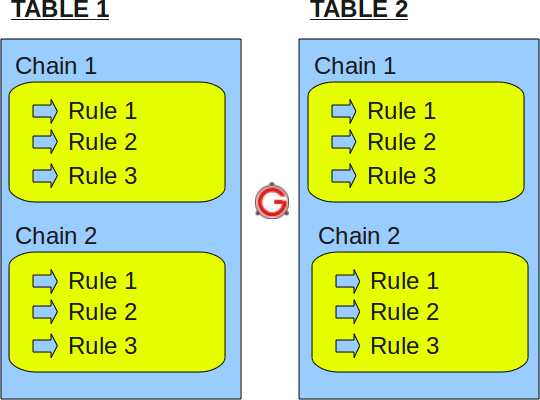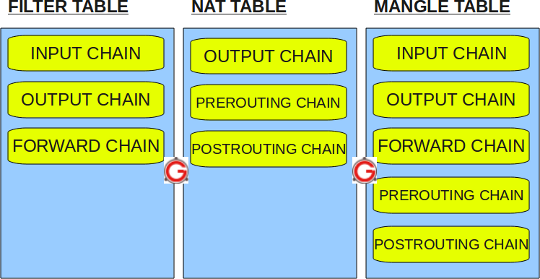- iptables applies to IPv4.
- ip6tables applies to IPv6.
- arptables applies to ARP.
- ebtables applies to Ethernet frames..
- /etc/init.d/iptables – init script to start|stop|restart and save rulesets.
- /etc/sysconfig/iptables – where Rulesets are saved.
- /sbin/iptables – binary.

Fig: IPTables Table, Chain, and Rule Structure
I. IPTABLES TABLES and CHAINS
1. Filter Table
- INPUT chain – Incoming to firewall. For packets coming to the local server.
- OUTPUT chain – Outgoing from firewall. For packets generated locally and going out of the local server.
- FORWARD chain – Packet for another NIC on the local server. For packets routed through the local server.
2. NAT table
- PREROUTING chain – Alters packets before routing. i.e Packet translation happens immediately after the packet comes to the system (and before routing). This helps to translate the destination ip address of the packets to something that matches the routing on the local server. This is used for DNAT (destination NAT).
- POSTROUTING chain – Alters packets after routing. i.e Packet translation happens when the packets are leaving the system. This helps to translate the source ip address of the packets to something that might match the routing on the desintation server. This is used for SNAT (source NAT).
- OUTPUT chain – NAT for locally generated packets on the firewall.
3. Mangle table
- PREROUTING chain
- OUTPUT chain
- FORWARD chain
- INPUT chain
- POSTROUTING chain
4. Raw table
- PREROUTING chain
- OUTPUT chain

II. IPTABLES RULES
- Rules contain a criteria and a target.
- If the criteria is matched, it goes to the rules specified in the target (or) executes the special values mentioned in the target.
- If the criteria is not matached, it moves on to the next rule.
Target Values
- ACCEPT – Firewall will accept the packet.
- DROP – Firewall will drop the packet.
- QUEUE – Firewall will pass the packet to the userspace.
- RETURN – Firewall will stop executing the next set of rules in the current chain for this packet. The control will be returned to the calling chain.
# iptables -t filter --list Chain INPUT (policy ACCEPT) target prot opt source destination Chain FORWARD (policy ACCEPT) target prot opt source destination Chain OUTPUT (policy ACCEPT) target prot opt source destination
# iptables -t mangle --list
# iptables -t nat --list
# iptables -t raw --list
# iptables -t filter --list (or) # iptables --list
# iptables --list Chain INPUT (policy ACCEPT) num target prot opt source destination 1 RH-Firewall-1-INPUT all -- 0.0.0.0/0 0.0.0.0/0 Chain FORWARD (policy ACCEPT) num target prot opt source destination 1 RH-Firewall-1-INPUT all -- 0.0.0.0/0 0.0.0.0/0 Chain OUTPUT (policy ACCEPT) num target prot opt source destination Chain RH-Firewall-1-INPUT (2 references) num target prot opt source destination 1 ACCEPT all -- 0.0.0.0/0 0.0.0.0/0 2 ACCEPT icmp -- 0.0.0.0/0 0.0.0.0/0 icmp type 255 3 ACCEPT esp -- 0.0.0.0/0 0.0.0.0/0 4 ACCEPT ah -- 0.0.0.0/0 0.0.0.0/0 5 ACCEPT udp -- 0.0.0.0/0 224.0.0.251 udp dpt:5353 6 ACCEPT udp -- 0.0.0.0/0 0.0.0.0/0 udp dpt:631 7 ACCEPT tcp -- 0.0.0.0/0 0.0.0.0/0 tcp dpt:631 8 ACCEPT all -- 0.0.0.0/0 0.0.0.0/0 state RELATED,ESTABLISHED 9 ACCEPT tcp -- 0.0.0.0/0 0.0.0.0/0 state NEW tcp dpt:22 10 REJECT all -- 0.0.0.0/0 0.0.0.0/0 reject-with icmp-host-prohibited
- num – Rule number within the particular chain
- target – Special target variable that we discussed above
- prot – Protocols. tcp, udp, icmp, etc.,
- opt – Special options for that specific rule.
- source – Source ip-address of the packet
- destination – Destination ip-address for the packet








